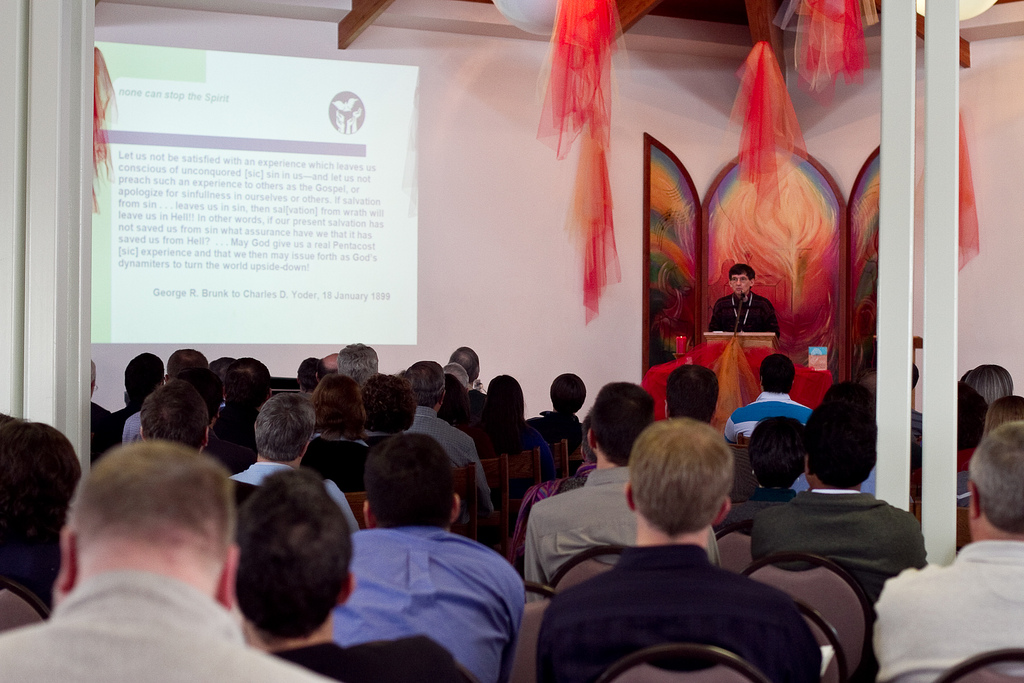HARRISONBURG, Va. – “How do we as human beings discern the supernatural power of the Holy Spirit in our midst?”
Nathan E. (Nate) Yoder, associate professor of church history at Eastern Mennonite Seminary and university archivist, reflected on that question in a special training session held Tuesday afternoon, Jan. 18, as part of the annual School for Leadership Training at EMS.
Dr. Yoder, whose research has focused on Christianity in North America, described ways that other faith traditions have influenced Mennonite beliefs and practice in relation to the third person of the Trinity, particularly in the late 19th and early 20th centuries.
In the broader Mennonite Church of the late 19th century, there was a desire to exemplify “authentic discipleship” while keeping at bay the “more emotional” aspects of the Methodist tradition, Yoder said, noting that Mennonites were concerned to avoid being “unequally yoked” with those whom they perceived as being “worldly” in their religious expression.
During the 1890s, Mennonites in Kansas drank deeply from the teaching of holiness preachers who claimed John Wesley’s legacy of emphasizing sanctification. As a young church leader, George R. Brunk (1871-1928) recorded his quest for a visitation of the Holy Spirit in his diary and letters. Brunk “sought to draw on the Spirit’s power to gain victory over moral failure, to be empowered for effective ministry and to lead others to experience fuller growth into holiness,” Yoder said.
In 1899, the Kansas-Nebraska Mennonite Conference passed a resolution stating that “The baptism of the Holy Spirit is as necessary to be obtained as conversion, and that it becomes the duty of every believer to seek and tarry until they have it definitely experienced.”
Thirteen years later, the conference took a less favorable stance toward sanctification as a separate, instantaneous experience. Still, Brunk, by then living in eastern Virginia, expressed holiness themes in the Mennonite church. He reinforced opposition to musical instruments and taught against worldly attire.
George R. Brunk II (1912-2002) son of George R. Brunk, sought to emphasize “the filling of the Holy Spirit” in his teaching and crusade work across North America. In 1972, when Brunk was dean at EMS, the seminary held a major “Consultation on the Person and Work of the Holy Spirit” on campus.
A book grew out of that event, and a mini-revival took place during fall spiritual life week on the EMU campus.
Yoder asked audience members to gather in small groups to reflect on a summary statement on “The Holy Spirit in the Life of the Church” that was adopted during a Mennonite General Assembly meeting in June, 1977 in Estes Park, Colo.
Respondent Lawrence M. Yoder, professor emeritus of missiology at EMS, told the group, “”We can only do what we do as disciples with the collaborative work and power of the Holy Spirit.”
“How can we remain (be) silent in sharing our experience together of the Holy Spirit?” said. Ervin R. Stutzman, former EMS dean and currently executive director of Mennonite Church USA. “Our faith grows as we hear and tell fresh stories of the work of the Holy Spirit and utilizes the gifts of the Spirit in our lives and ministry.”
Yoder recommended a book by Myron S. Augsburger, evangelist and former EMU president, “Quench Not the Spirit” (Herald Press), which he realized is marking the 50th anniversary of its publication “but merits reading today.”
